Researching competitor keywords is an extremely popular SEO tactic. Almost every SEO company or blog post about keyword research mentions it. But, an absolutely critical fact that many marketers overlook is that your competitors probably rank for a lot of useless keywords that hold no value to your business.
Specifically, in our experience, most companies follow a herd mentality where they all research each other’s keywords and copy each other. That results in everyone in a space targeting the highest search volume keywords they can find.
On the surface, this seems fine. More search volume means more traffic. But as we’ve argued in many articles and shown in a ton of case studies, traffic and pageviews don’t equate to actual conversions (like leads, demo requests, or contact form fills).
So if you blindly follow your competitor’s keywords, it’s extremely likely that you’ll end up where they very likely are: with a bunch of content that gets traffic but doesn’t convert.
Instead, what you should do, and what we’ve stressed many times, is prioritize keywords that show buying intent. These are the keywords that indicate readers’ active interest in your product or services; they target audiences who are: 1) a good prospect for your business and, 2) ready to take action — and they convert at a much higher rate than other keywords. These keywords are the hidden gems in your competitors’ SEO profiles.
This helps turn SEO and content marketing into a revenue-generating, ROI-positive channel.
Below, we’ll explain this logic and show you how to find the most valuable opportunities from competitors’ content plans.
Note: You can learn more about how our agency approaches content marketing and SEO here or inquire about working with us here. We also teach our content marketing strategy and process in our course and community.
Flaws with the Traditional Approach to Researching Competitor Keywords
Usually, the approach to researching competitor keywords looks like this:
- You plug competitors’ sites into Ahrefs or Semrush to see a list of keywords they’re ranking for.
- You identify gaps between your content and their content. (What keywords have they targeted that you haven’t? Where are they outperforming you on the SERP?)
- Then, you “bridge the gap” by targeting keywords they rank for that you don’t.
But the key is that last step: Which of the “gap” keywords do you actually go after? As we argued above, we think the vast majority of keywords your competitors rank for are not useful to you. Specifically:
- Many are just obvious duds. Things like branded keywords for them and terms that just don’t apply to your product or service. It’s easy to weed these out.
- Top-of-funnel keywords that won’t ever convert. These are the tempting ones. If your competitor ranks for some high-traffic keyword in your space, it’s really hard to not go after those same keywords. But if you can avoid this temptation and filter their keywords by buying intent for your products or services, you will have a much higher ROI on your SEO and content efforts.
To convince you why #2 is important, let’s look at a case study of one of our clients.
Case Study: Geekbot and the Power of Bottom of Funnel Keywords
For our client, Geekbot, we measured conversion rates by keyword type to assess how different opportunities and pieces of content were working for them.
Overall, we looked at 64 articles: 22 targeting bottom-of-the-funnel keywords — this is another term we’ve used to describe high-buying-intent keywords — and 42 targeting top-of-the-funnel content (a.k.a., educational or awareness-style content to drive traffic and introduce readers to your brand).
Over two years, these posts brought in 232,493 organic page views — as you might expect, TOF brought in the majority of that organic search traffic: 204,303 website visitors. BOTF keywords generated 28,190 page views.
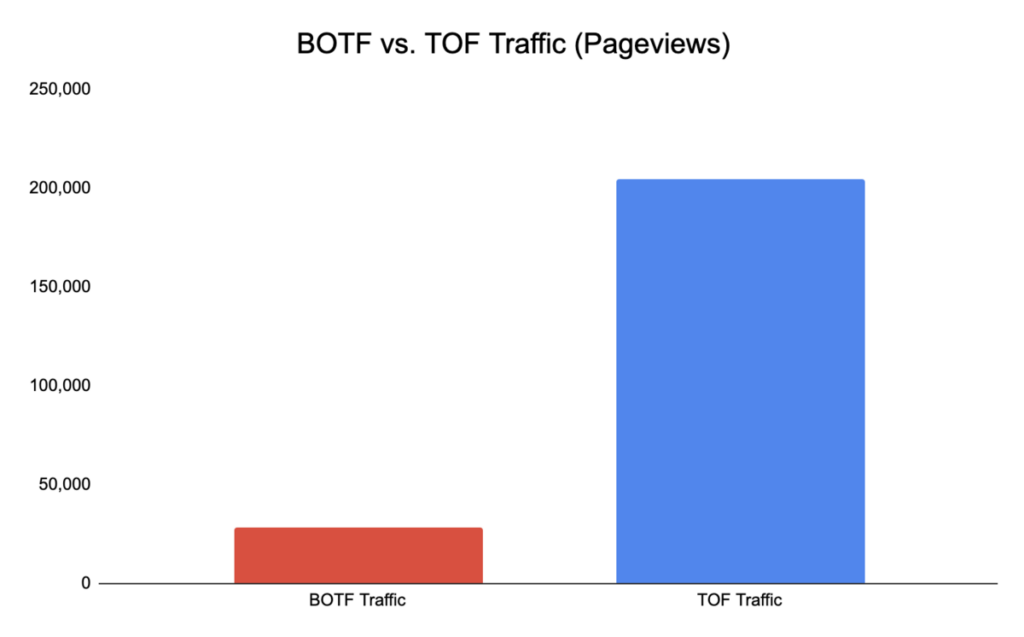
But despite TOF content bringing so many more visitors to the site (10x more!), BOTF content still drove more business: keywords with high buying intent converted at a 25x higher rate than top-of-the-funnel content.
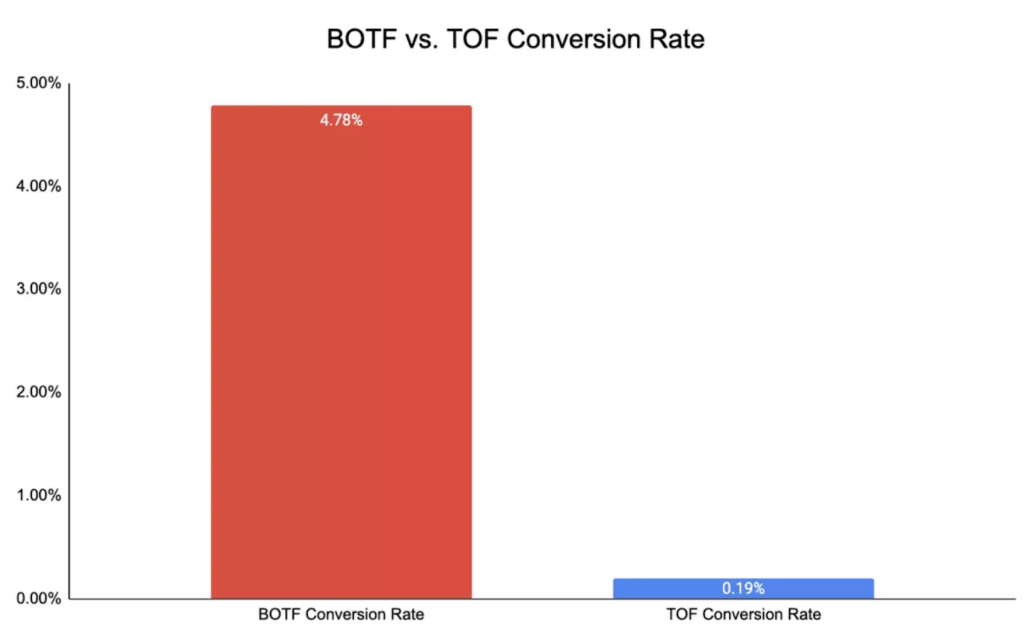
Geekbot’s top-of-the-funnel keywords brought in 397 conversions with a conversion rate of 0.19%. On the flip side, the bottom-of-funnel keywords brought in 1,348 leads and converted at 4.78%.
That’s why we continually say that maximizing conversions over traffic is more valuable.
You’ll achieve ROI sooner by targeting competitor keywords with high buying intent. Then, after you exhaust those opportunities, you can move “up the funnel” to more brand-building keywords.
Pain Point SEO and the 3 Categories of High-Buying-Intent Keywords to Look For
Our foundational framework for targeting high-buying-intent keywords — something we coined as Pain Point SEO — classifies high-buying-intent keywords into three categories.
The idea here is that any company can follow this framework to identify high-buying-intent opportunities (and avoid the pitfalls discussed above) when finding competitor keywords to target. And we’ve seen this strategy work time and time again.
1. Category Keywords
Category keywords indicate that someone is literally searching for your product or services. They’re usually pretty obvious and easy to think of. For example, say you are developing a keyword strategy for a help desk software company (an example we walk through in detail below); you’d want to rank highly for keywords like “help desk software,” “email ticketing system,” and “customer service software.”
When somebody is researching a product or service category, they’re in the process of learning about available solutions and comparison shopping — so if somebody is searching for the product or service you offer, you’d obviously want to introduce your solution to those readers.
The trick here is to think of the different ways somebody might look for your solution; an HR user exploring help desk software might search “email ticketing system,” while a customer service user might search “customer service software.” Either way, both users are looking for help desk software, so you’d want to target those variations of your product category.
When performing competitor keyword research, you can look at the category keywords they target and find options that tie back to your product or services. We recommend looking at your closest competitors here — the competitors with offerings most similar to yours — because their category keywords will be more appropriate for your business.
2. Comparison and Alternative Keywords
Comparison and Alternative keywords indicate Googlers are researching and comparing competitor brands, products, and services — they could be transitioning away from a competitor’s solution, or aware of your competitor’s brand and curious about alternatives… but again, we know this searcher is in the market for what you offer and trying to decide on the right solution. So it makes sense to be a part of this conversation.
For example, in the help desk space, somebody might research “Zendesk alternatives” (or “Zendesk competitors”) because Zendesk is a well-known help desk software brand. Or they might research Zendesk vs. [other help desk competitor name] to see how one solution stacks up against another. We talk more about the value of these keywords in our case study here.
This is a valuable strategy when analyzing competitor keywords because you can discover new brands (you may compete with directly or in search engines) and stay on top of competitors’ competitors. Pursuing these keywords lets you introduce your brand to audiences who are interested in products or services that closely relate to what you offer.
3. Jobs To Be Done (JTBD) Keywords
Jobs To Be Done keywords lean more into the idea of “pain point SEO” because they indicate that the Googler is experiencing a problem or pain that your solution can solve. Though users aren’t directly searching for your solution (or a competitor’s), like the categories above, these keywords still indicate buying intent because users require a solution to a current problem (or have a job that needs to be done).
JTBD keywords present an opportunity to “drive awareness” because Googlers may not be aware of your solution — but you’re driving awareness to more qualified searchers, instead of starting at the top of the funnel.
Circling back to our help desk example, some JTBD keyword ideas would include: “how to organize customer support emails,” “how to manage a team inbox,” or “how to create and send automated support emails.” All of these search terms indicate that the Googler has a problem help desk software solves, so introducing this solution to readers means there is a chance they’ll convert and make a purchase.
This is useful when researching competitor keywords because you can learn more about your target audiences’ pains — pains you might not have thought of or realized from past customer conversations — and determine the best ways to position and present your solution.
Look at our diagram below to visualize these keyword categories “in the funnel:”
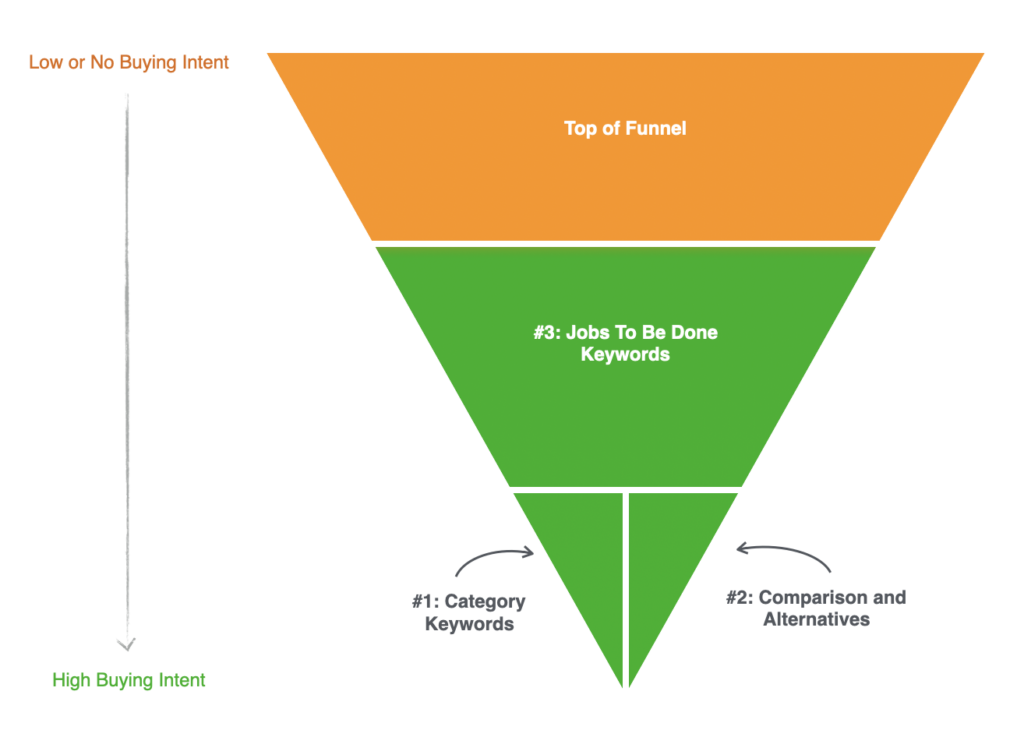
How to Apply This in Your Competitive Keyword Analysis
Now we’ll show you how this works with an example — I’ve done this competitive keyword research for the company HiverHQ (not a client and totally unaffiliated to us) to see how they compare to bigger help desk software brands, like Zendesk, Freshdesk, and HelpScout.
There are several digital marketing and keyword analysis tools to perform this research, including Moz, Semrush, and Ahrefs. We use Ahrefs in our processes, but you can also follow these steps in other SEO tools.
The first step is to open Ahrefs and navigate to “Site Explorer”.
Here, you can paste your site URL to get a bird’s-eye view of your site’s keyword data, backlink profile, and traffic sources. Then, open the “Content gap” tool to add competitor URLs and review their keywords.
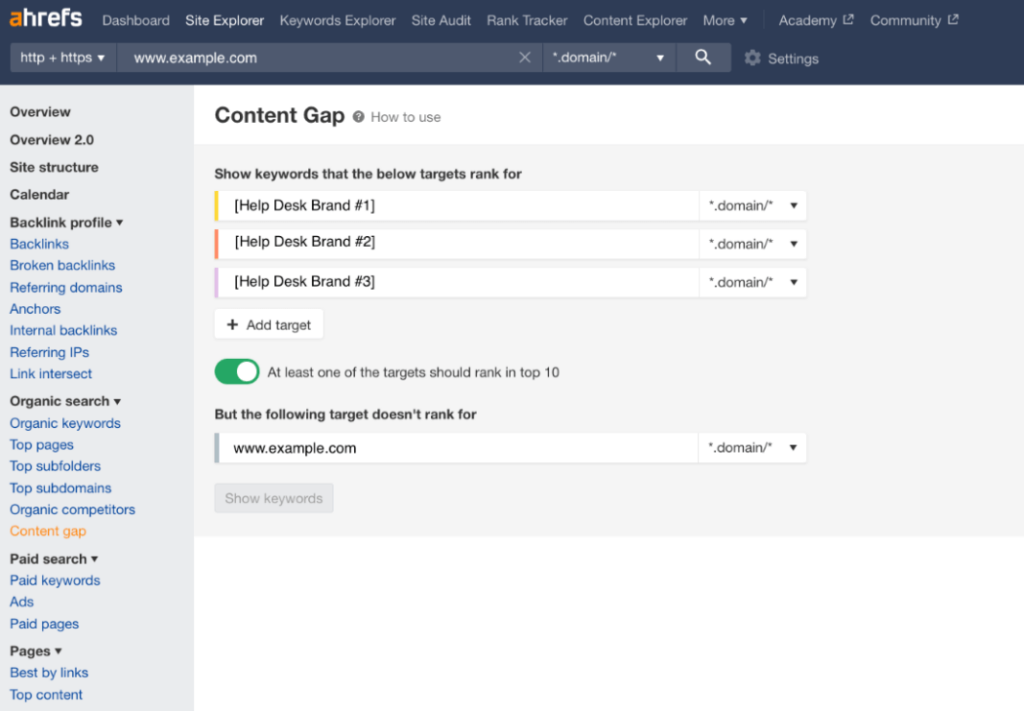
When you run the content gap report, you’ll be hit with pages and pages of organic keyword options — this is the time to sift through keywords and find the opportunities worth prioritizing. Ahrefs will show you competitor rank positions and metrics like keyword volume and difficulty, which you can use to filter options (to a degree). As we’ve stressed above, you should prioritize search and buying intent above all else.
Competitor keyword analysis will require a time investment, but doing this research upfront lets you pinpoint the valuable keywords and avoid wasting resources on opportunities with no business potential.
Let’s review the keyword gap report below:
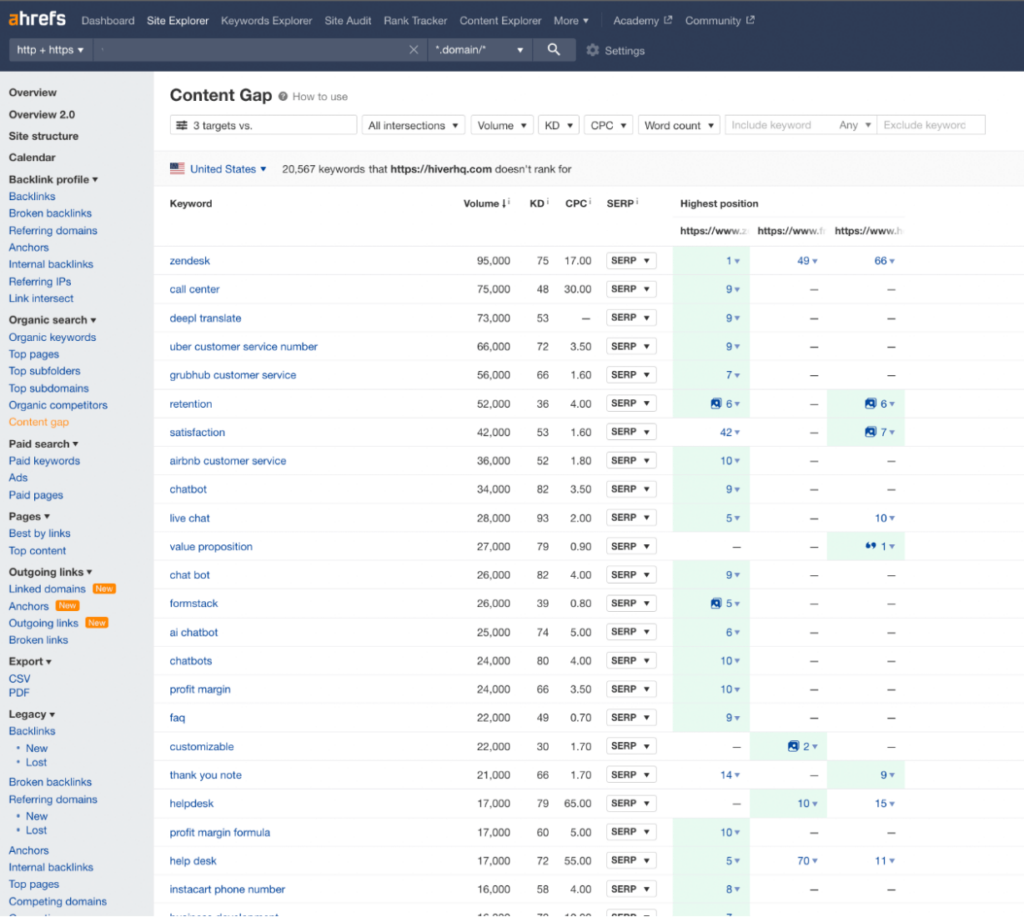
First, there are the obvious duds: “Uber customer service number” (and similar keywords) are not at all related and easy to weed out.
However, we can spot category keywords that could be relevant — like AI Chatbot. Most help desk tools include or offer an AI Chatbot, so if your tool also has an AI chatbot (or related) feature, targeting this keyword could get you in front of the customers looking for that software solution.
If it doesn’t, it’s not relevant to you, and you should move on. This illustrates a key point: what is a bottom-of-funnel term for your competitor isn’t necessarily a relevant keyword for you.
Another keyword later on this list is “enterprise customer service software,” which is a super valuable opportunity for help desk software brands targeting enterprise users.
Think about the types of buying intent keywords we described above while you perform gap analysis. You can filter the keyword research tool by term to find topics that fall into those buckets. For example, you could type “software” (or feature names, like AI Chatbot) to see every keyword that mentions a specific software category or solution. Or you could find “alternative” keywords by looking for competitor names.
As you review each keyword, think about the searcher and:
- The questions they have
- The problems they want to solve, or tasks they want to accomplish
- The goal of their research
When you consider the search intent — and really put yourself in the reader’s shoes — you can gauge business potential and identify “pain point” keywords. Is this searcher looking for a product or service? Do they have a problem and are seeking a solution? Do YOU have a good solution for this Googler?
Then, you can review the content gap report and hone in on the specific keywords that make the most sense for your business.
Also, keep in mind, there are usually a few overarching goals teams have when digging into competitor keywords:
- Target the same (high-buying-intent) keywords as competitors to compete for rankings in the same search engine results pages.
- Discover pain point, JTBD, and long tail keywords used by your target market that you hadn’t thought of yourself.
- Find and begin targeting keywords that competitors have not yet targeted.
Establish specific goals before building out your content plan. Is there an audience you want to target, like enterprise teams? (Alternatively, are there audiences you want to avoid?) Do you want to promote certain product features? Was your product designed to solve very specific problems? You can implement our strategies while still driving research around your goals.
On that note… let’s talk about finalizing keyword ideas and developing strategies to target competitor keywords.
Dotting Your I’s & Crossing Your T’s
By now, you should have a pretty good list of keywords to slot in your content plan. But before you start tackling topics, there are two remaining steps:
First, you want to perform brief SERP research to finalize keyword ideas and ensure each option is solid.
This includes opening the search engine results page for target keywords and checking out your organic competitors (who already ranks in the top #1-10 positions).
- What type of sites do you see?
- Who are you competing with?
- What type of content have they produced on the topic?
- Does it make sense to introduce your business/solution to this conversation?
Finally, if everything checks out and you determine the keyword presents a strong opportunity for your business, you can decide on the SEO strategy to target it.
- Think about your existing content — are there any opportunities to update and re-optimize current content to rank for these new keywords? (Then, you can boost ROI from previous content marketing and reserve resources to build new content.)
- Look at the overlapping keywords that you and your competitors have both targeted; determine where they out-rank you, and schedule updates to that content.
- Build new content to target remaining keywords.
It’s important to remember that finding the right keywords is only a small part of strategic SEO. Even if you identify the most valuable keyword opportunities, you will only see success from content marketing by delivering helpful, well-written content that caters to search intent.
We won’t dive into all of that in this post, but you can read about the next steps of our process here: SEO Content Writing: A 5-Step Process You Can Follow
Want to Work with Us or Learn More About How We Approach Content Marketing?
- Our Agency: If you want to hire us to execute content marketing in this way, you can learn more about our service and pricing here.
- Write For Us: If you’re a content marketer or writer and would love to do content marketing this way, we’d love to have you apply to join our team.
- Our Content Marketing Course: Individuals looking to learn our agency’s content strategy and become better marketers, consultants, or business owners can join our private course, taught via case studies, and presented in both written and video content formats. We include several details and examples not found on this blog. Our course is also built into a community, so people ask questions, start discussions, and share their work in the lesson pages themselves, and we, along with other members, give feedback.








